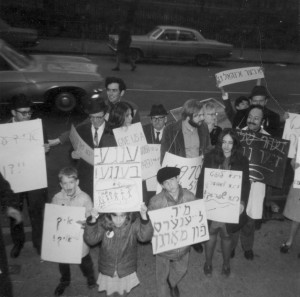Planning for the Jewish Future: A Lecture by Dr. Rakhmiel Peltz
by ROBERTA NEWMAN
On February 17, 2015, about 60 dedicated YIVO members and others braved a cold and snowy evening to attend “Planning for the Jewish Future: Standards for Yiddish in the 20th and 21st Centuries,” a lecture by YIVO’s new Atran Visiting Professor of Yiddish Language and Linguistics, Rakhmiel Peltz (Drexel University), followed by a panel discussion by three scholars.

the editorial offices of New York Yiddish newspapers against lax
standards in spelling and usage, East Broadway, New York City,
April 1970. (3rd from left) Dr. Mordkhe Schaechter; (4th from left)
Khane Kliger; (near center) Rakhmiel Peltz. Front row from left to
right: Binyumin Schaechter, Eydl Schaechter Resnick, and Avreml
Fishman.
In his talk, Rakhmiel Peltz introduced the audience to the role of standards in society in general, using examples from research in the biomedical sciences, as well as the economics of natural resources. For example, he recounted how contemporary researchers published a thousand articles seemingly on breast cancer metastesis, using skin cancer cells by mistake. Adherance to standards in society represents a concern for the common good, in opposition to individual whims. So too is the modern history of standards for Yiddish language linked to the devotion of the leading Yiddish language and culture planners to the needs and future of the Jewish people as a whole. Peltz illustrated this dedication by following the normative work of Yiddish standardizers, including Nathan Birnbaum (1864-1937), Ber Borokhov (1881-1917), Uriel Weinreich (1926-1967), and Mordkhe Schaechter (1927-2007). These leaders were deeply concerned with Jewish continuity and a rich Jewish future.
The panel discussion that followed was something of a referendum on the Jewish future in the 21st century. The moderator, Dr. Edward Portnoy (Rutgers University/YIVO Academic Advisor) posed the question: how key is language to Jewish continuity, identity, and culture in the 21st century? He noted that the largest Jewish communities in the world today are monolingual (something new in Jewish history). Can there be, he asked, Jewish culture without a Jewish language?
Dr. Ronnie Perelis (Assistant Professor of Sephardic Studies, Yeshiva University) began the discussion by noting the parallels between Yiddish and Ladino after the expulsion of Jews from Spain and Portugal in the 15th century. Before the expulsion, Sephardic Jews spoke Spanish, the language of the streets, but wrote it in Hebrew characters. Ladino truly became a Jewish language only in exile, serving as a marker and preserver of Jewish identity.
Yiddish scholar Dr. Adina Cimet suggested that Jews are in “a state of crisis,” and have not recovered from the traumas of the 20th century, “since we are still being wiped out, linguistically.” There is no critical mass of children speaking and learning Yiddish because Jewish communal leaders and institutions have not fought for it, not advocated for it. Without Yiddish, Jews will have access only to an infinitesimal fraction of their own heritage. Without the key of language, the door to that past is forever locked.
Watch a video of the event.